Key takeaways:
- Choose a crypto trading platform carefully, focusing on security, usability, and fees to enhance your trading experience.
- Be wary of scams, such as promises of guaranteed returns, poor customer support, and unsolicited communications.
- Research the platform’s reputation through independent reviews and check for genuine regulatory compliance to ensure safety.
- Pay attention to the platform’s withdrawal process and community engagement for additional security indicators.
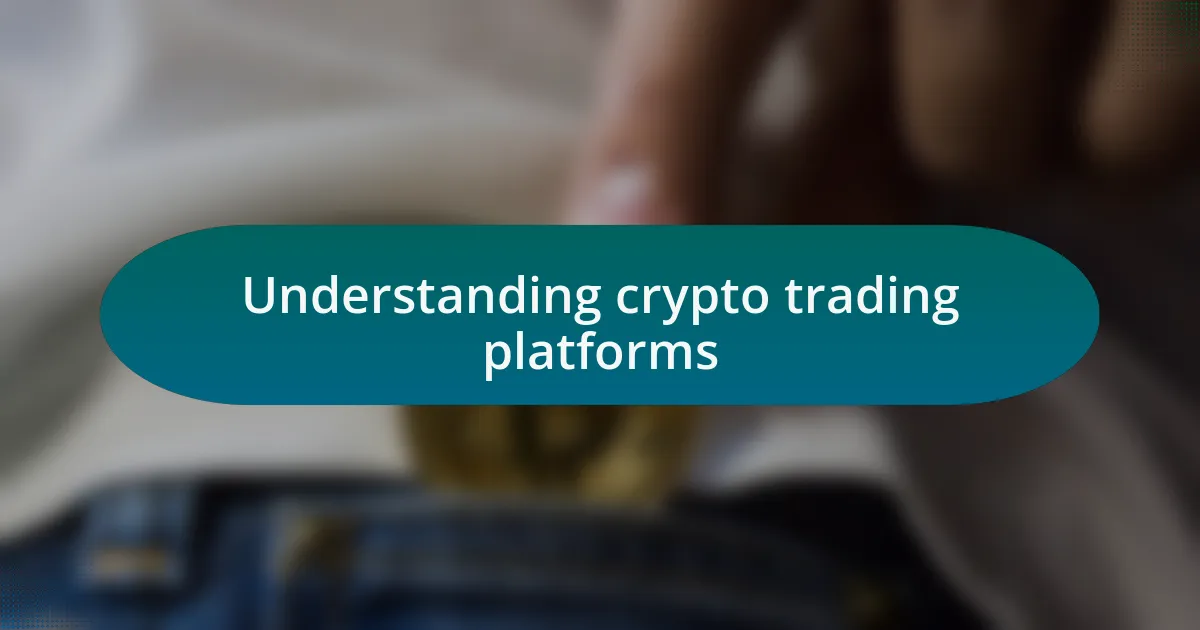
Understanding crypto trading platforms
Crypto trading platforms serve as the gateways for those entering the world of digital currencies. I remember the first time I used one; it felt like stepping into a bustling marketplace filled with excitement and uncertainty. It’s crucial to understand that these platforms vary significantly in terms of security, usability, and fees, which can influence your overall experience.
When I first explored the features of different platforms, I often found myself asking, “Which one really caters to my needs?” Each platform offers its own unique tools and resources for trading—some prioritize user-friendliness for beginners, while others focus on advanced analytics for seasoned traders. This diversity can be overwhelming, but it also means you have options tailored to your specific trading style.
Additionally, understanding how a crypto trading platform operates is vital for your investment’s safety and success. Have you ever felt the rush of making a successful trade, only to realize later how essential it was to choose a platform with robust security measures? The experience taught me that the right platform not only enhances your trading strategy but also provides peace of mind in an unpredictable market.
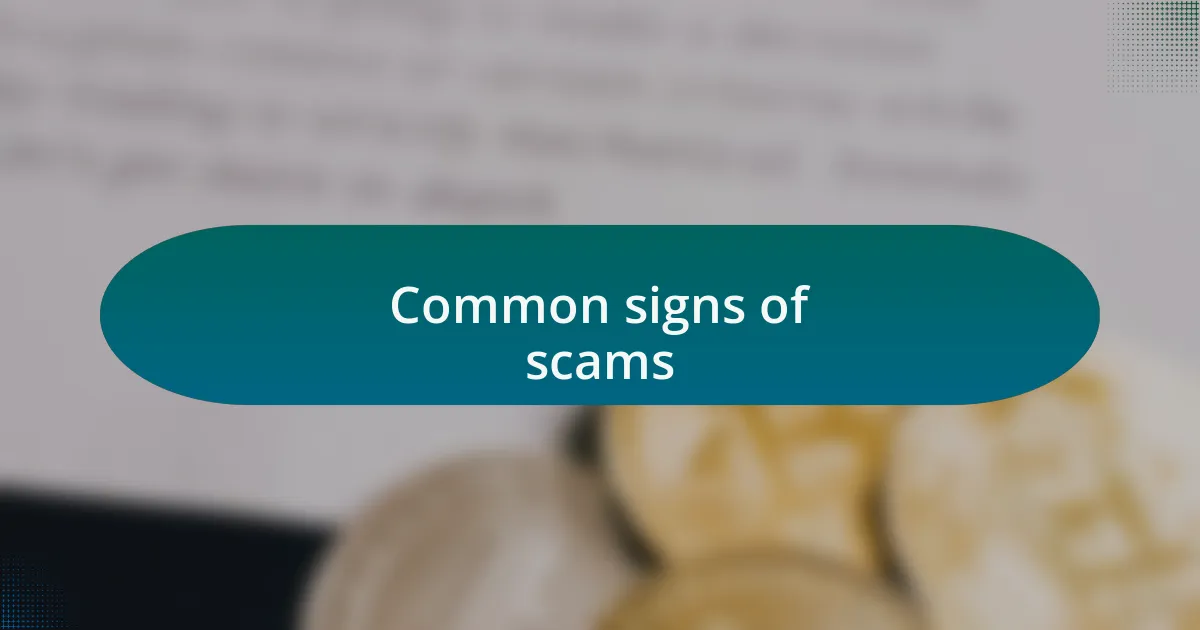
Common signs of scams
One of the most glaring signs of a scam is the promise of guaranteed returns. If a platform promises you high, risk-free profits—especially in a volatile market like crypto—it’s a red flag. I remember stumbling upon a site that boasted an incredible 200% return within a month. It seemed too good to be true, and trust me, it was.
Another warning sign is poor or nonexistent customer support. When something went wrong during one of my trades, I reached out to a platform but received no response. The silence was unnerving and made me question their legitimacy. If a platform can’t answer your queries, how will they handle your funds?
Lastly, look out for unsolicited communication, like emails or messages promising you exclusive deals. I once received a message claiming I’d won a trading competition I never entered. It felt like being lured into a trap. If you didn’t initiate the conversation, be wary—genuine platforms don’t hunt you down to offer “once-in-a-lifetime” opportunities.
Researching the platform’s reputation
Researching a crypto platform’s reputation is crucial before committing your hard-earned money. I recall a time when I was enticed by a platform that had flashy advertising but a questionable online presence. A quick search turned up numerous complaints from users who felt they were misled. If a platform has countless unhappy customers, should you really trust them?
When I dig deeper into a platform’s reputation, I always check user reviews on independent forums and social media. There was an instance where I found a platform with glowing testimonials on its own site, but several forums revealed a very different story. This discrepancy made me ponder, why would a platform need to hide the voices of its users? It highlighted the importance of cross-referencing information.
Another important step is to investigate any regulatory compliance. I once came across a platform that claimed to be regulated in multiple jurisdictions, but a little digging revealed its license was issued by a barely known authority. This experience made clear that not all regulatory banners are created equal. It’s essential to discern whether a platform is genuinely compliant or merely using a façade to appear legitimate.
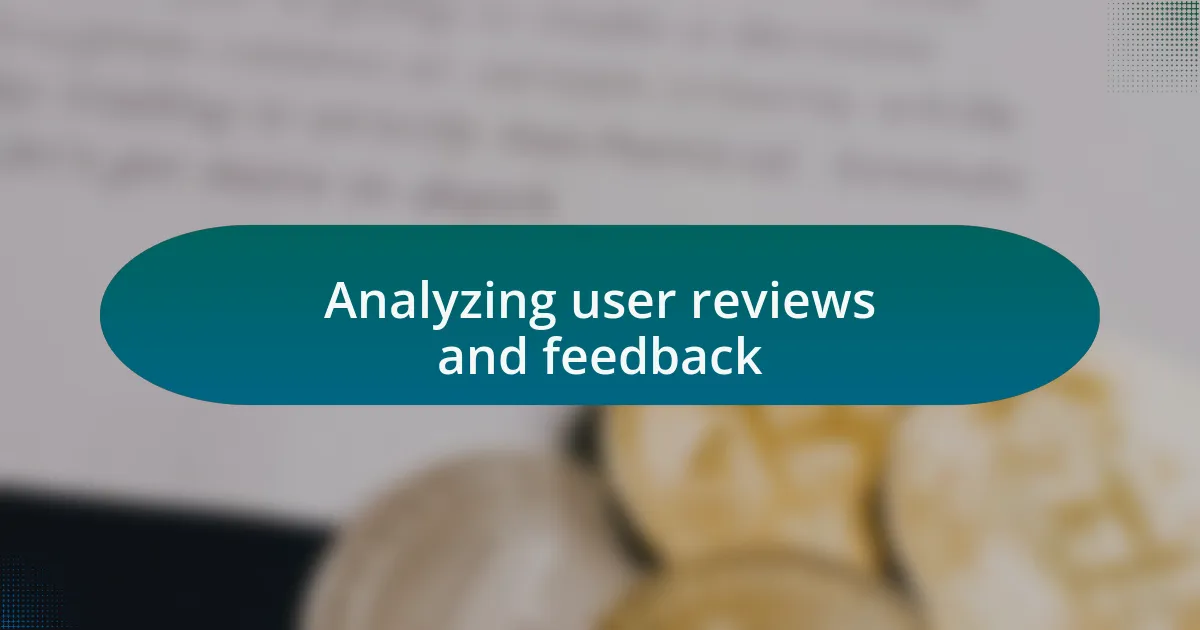
Analyzing user reviews and feedback
When analyzing user reviews and feedback, it’s important to consider not just the quantity but the quality of those reviews. I remember one platform where the reviews were overwhelmingly positive, yet the comments seemed overly generic. They felt like they were written by the same person, which prompted me to question the authenticity of those voices. It left me wondering, how can one truly gauge a platform’s reliability if the feedback is curated without diversity?
I often find that diving into negative reviews sheds more light than the positive ones. There was a time when I came across a platform that had a slew of complaints regarding customer service. Users described long wait times and frustrating resolutions. I couldn’t help but think, if they struggle to support their customers, what happens when you actually need help? This experience reinforced my belief that red flags often hide in the less-than-glowing feedback.
Moreover, I encourage seeking user experiences beyond the platforms themselves; independent review sites can be a goldmine. I once discovered a critical review on an obscure site from a user detailing a withdrawal issue that was a deal-breaker for me. That one genuine account highlighted the need for thorough scrutiny. It made me realize that behind every review is a person with a story, and it’s those stories we must attend to in our quest for safe trading.
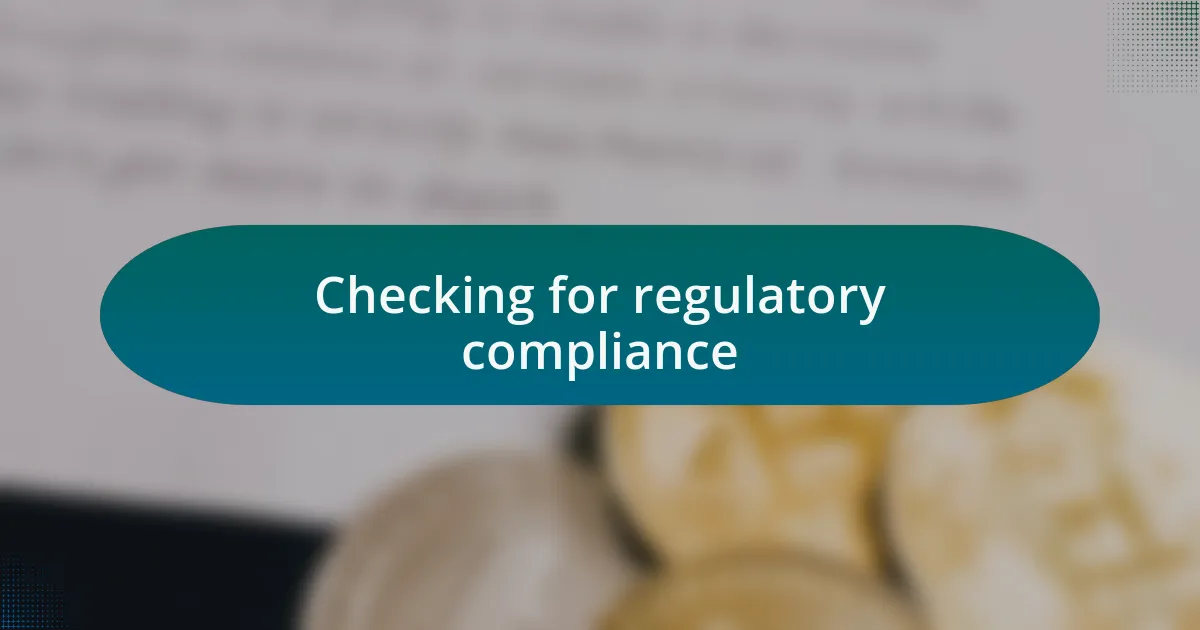
Checking for regulatory compliance
Checking for regulatory compliance is crucial when evaluating a crypto trading platform. I recall my experience with a certain exchange that proudly displayed its regulatory certifications. However, a closer inspection revealed that these credentials were either outdated or from obscure jurisdictions. It left me questioning, how effective are these regulations if they aren’t actively enforced or monitored?
Understanding the regulatory framework can sometimes feel overwhelming, but I recommend breaking it down. In my journey, I’ve learned about the significance of platforms being regulated by recognized authorities, such as the SEC in the United States or the FCA in the UK. These bodies provide a layer of security and transparency that can significantly impact your trading experience. I remember chatting with a fellow trader who initially overlooked this aspect; he later shared how a lack of regulatory oversight led to significant losses.
When I assess a platform’s compliance, I not only check for these licenses but also look for any disciplinary actions taken against them. There was a platform I once considered that had faced multiple fines for failing to meet compliance standards. It raised a red flag for me—if they weren’t adhering to regulations, how could I trust them with my investments? Always ask yourself, what’s behind the shiny facade of compliance claims?
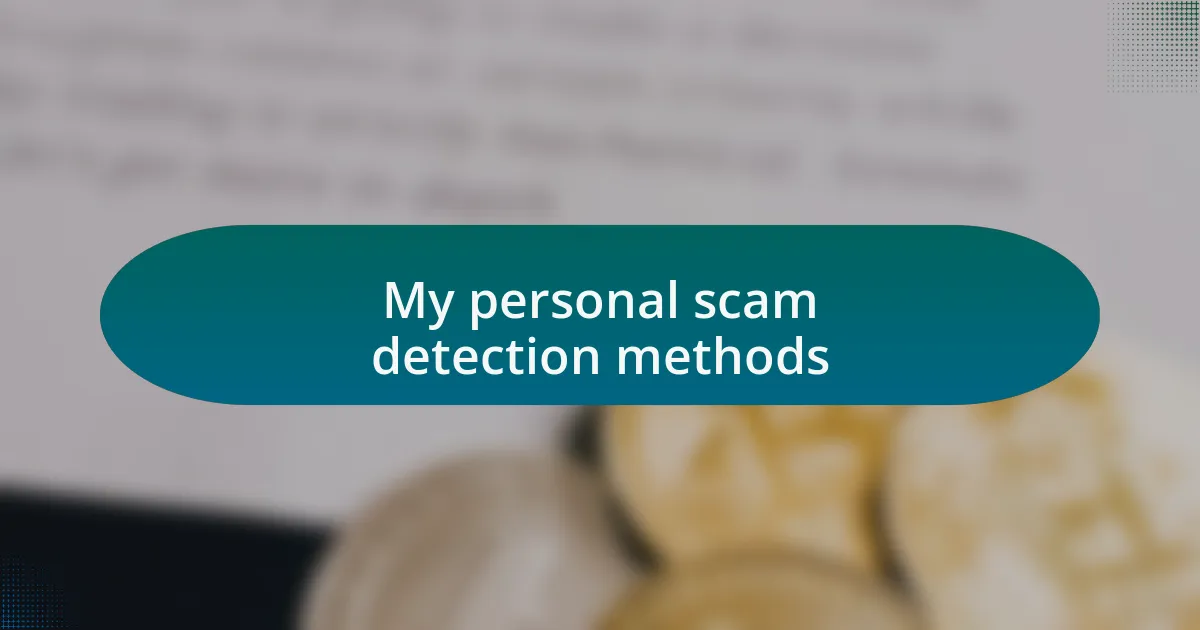
My personal scam detection methods
When evaluating a potential trading platform, I make it a point to scrutinize user reviews and feedback. In one instance, I stumbled upon a platform with overwhelmingly positive ratings, but a bit of digging uncovered numerous complaints hidden in less visible corners of the internet. This experience taught me that sometimes, the loudest voices in a review section might not tell the whole story. How many times have you seen a stellar rating for a service that simply didn’t deliver?
I also pay close attention to red flags in communication styles. I recall a platform reaching out with promises of guaranteed returns and extravagant bonuses. It felt too easy, almost like a fairy tale eager to lure in unsuspecting traders. It made me reflect: if it sounds too good to be true, perhaps it is. I trust platforms that maintain open lines of communication and offer clear, realistic expectations rather than those that rely on flashy promotions.
Lastly, analyzing website transparency is something I never overlook. On one occasion, I encountered a site that lacked clear contact information and didn’t provide easy access to terms of service or privacy policies. It felt like trying to navigate a murky pond—how could I safely invest without knowing who I was dealing with? In my experience, the more transparent a platform is about its operations, the more trustworthy it tends to be. After all, credibility is built on openness and accountability.
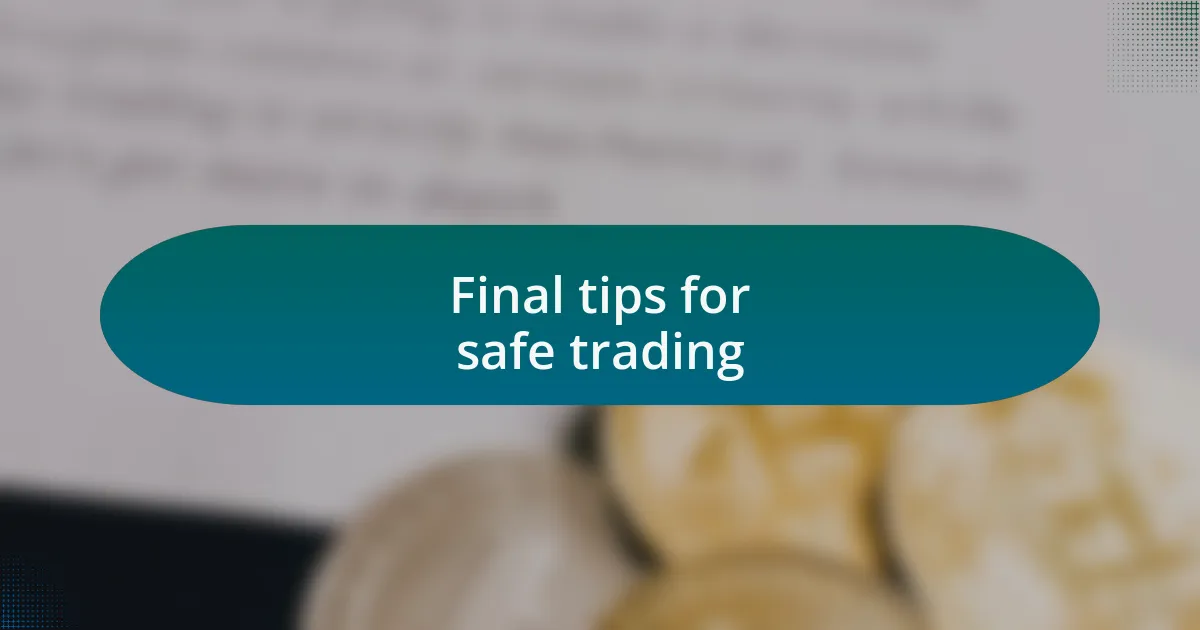
Final tips for safe trading
When it comes to safe trading, always double-check the legitimacy of the platform you plan to use. I recall a time when my initial excitement about a new exchange fizzled out as I discovered it lacked proper regulation. Isn’t it disheartening to think you could get caught up in a scam simply because you skipped that crucial step?
Another tip I swear by is to keep an eye on the withdrawal process. I’ve had experiences where platforms made it incredibly difficult to withdraw my funds, raising immediate red flags. Sure, it might seem tedious, but asking about withdrawal times and fees can save you from a frustrating situation later on. Why risk your hard-earned money when these questions can provide clarity upfront?
Lastly, don’t overlook community involvement and updates from the platform. I remember following one platform that regularly shared insights and engaged with its users on social media. Their transparency and willingness to connect gave me a sense of security. If a platform is enthusiastic about sharing knowledge and responding to user queries, it’s a good sign that they care about their community—and your investment.